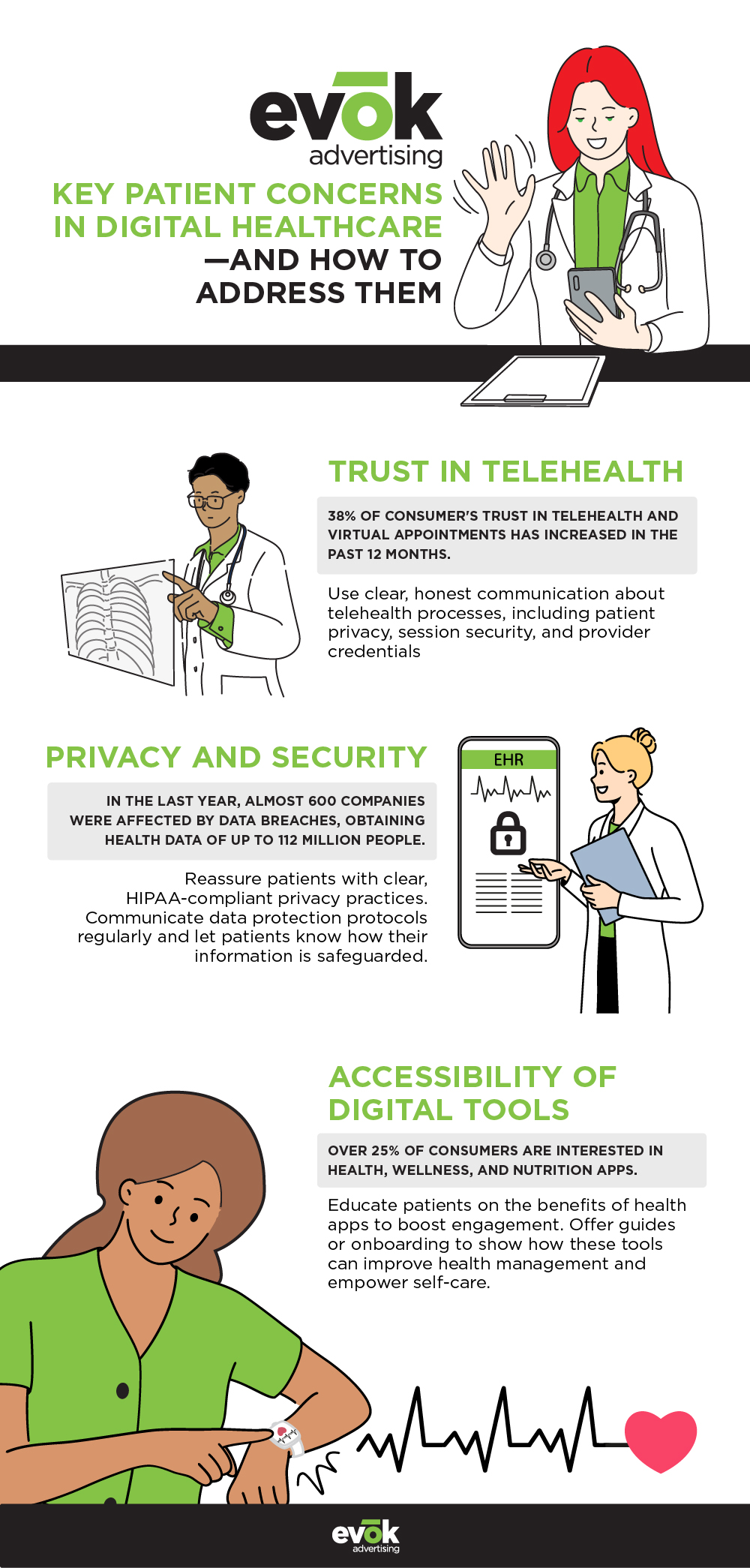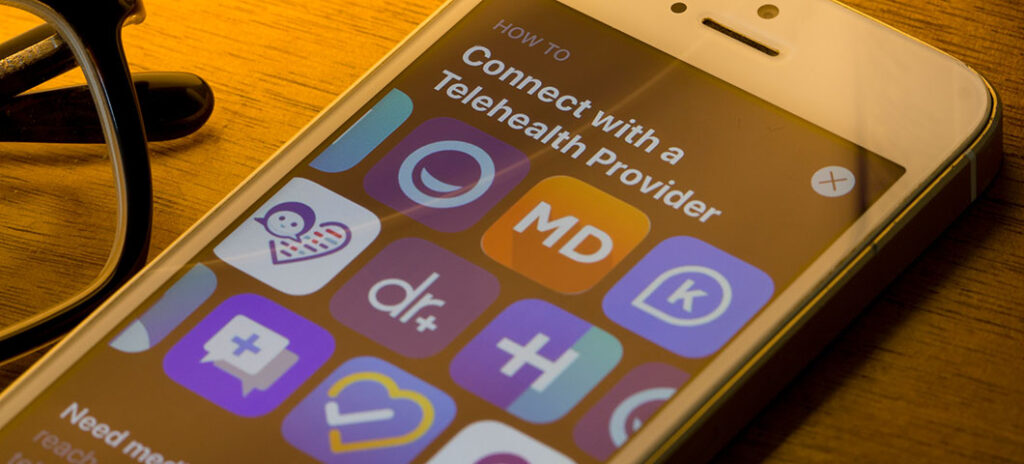
Healthcare Digital Transformation: 7 Marketing Strategies to Increase Patient Acquisition
Digital transformation isn’t just a trend—it’s a necessity in today’s healthcare landscape. For healthcare providers, Chief Marketing Officers (CMOs), and industry leaders, meeting the needs of modern patients means going beyond traditional engagement methods. Now more than ever, patients expect access to high-quality care and seamless digital experiences that prioritize their unique needs, respect their privacy, and address the accessibility gaps still in the system.
The challenge? Creating a marketing approach that does more than inform. It must engage, build trust, and ultimately drive patient acquisition in ways going beyond what is commonly found in healthcare marketing. In this blog, we’ll explore seven advanced digital marketing strategies designed to help you meet these demands head-on. These strategies aren’t just about patient acquisition; they’re about building loyalty, establishing long-term trust, and positioning your healthcare brand as an essential partner in each patient’s healthcare journey.

1. Embrace Data-Driven Personalization for Patient Engagement
Today’s patients expect a healthcare experience tailored to their unique needs and preferences, and using data to drive personalized marketing can significantly impact patient acquisition and retention. Healthcare providers can create personalized messaging to build trust and foster loyalty by leveraging demographic, behavioral, and health-related data.
Why It Matters:
Patients increasingly want healthcare providers to understand and anticipate their needs, especially as healthcare is digitized. According to our research, the desire for personalization is a critical factor for patients, with many favoring healthcare providers who offer experiences relevant to their health journeys. Data-driven personalization can help you address this expectation by delivering customized content and recommendations to reflect patients’ unique health profiles.
How to Implement This Strategy:
- Segmentation for Targeted Messaging: Start segmenting your audience based on specific health needs, demographic factors, or engagement behaviors. For example, targeted email campaigns can deliver specialized content to patients with chronic conditions, encouraging proactive engagement with preventive services.
- Utilize Patient Journey Mapping: Identify critical touchpoints in the patient journey, from awareness to follow-up care, and tailor content accordingly.
- Invest in Advanced Analytics Tools: Advanced analytics and CRM systems are invaluable for personalizing patient interactions. By capturing and analyzing data on patient behavior, you can continually refine your approach to meet evolving needs.
2. Enhance Accessibility through Telehealth Promotion
Telehealth has transformed healthcare by making it accessible to patients regardless of location, which is critical for patient acquisition, especially in rural or underserved areas. As demand for telehealth services rises, promoting these offerings can expand your reach and provide convenient care options.
Why It Matters:
Our research indicates telehealth services have gained trust and acceptance among patients, with 38% reporting increased trust in virtual healthcare. For many, telehealth fills a crucial gap, providing more accessible, flexible, and timely medical services. By marketing these options effectively, healthcare brands can attract patients who might otherwise face barriers to care, such as distance, limited mobility, or time constraints.
How to Implement This Strategy:
- Targeted Advertising in Remote Regions: Direct marketing efforts toward regions with limited access to healthcare facilities, emphasizing the convenience of telehealth as an alternative to in-person visits. Consider geo-targeted ad placements in rural or underserved areas.
- Educational Content on Telehealth Benefits: Create and share informative content (blogs, videos, social media posts) explaining telehealth’s benefits, such as 24/7 access, reduced travel, and faster consultations.
- Highlighting Security and Compliance: Patients may hesitate about telehealth due to data privacy concerns. Emphasize your telehealth platform meets all HIPAA compliance standards and outlines the security measures to protect patient data.
3. Build Trust with Transparency in Digital Communications

Trust is the foundation of any successful healthcare provider-patient relationship, yet many consumers still harbor skepticism toward the healthcare system. You can alleviate these concerns by prioritizing transparency in your communications, building credibility, and enhancing patient acquisition efforts.
Why It Matters:
Our research shows most consumers view the healthcare system as only “somewhat trustworthy,” which can impact their willingness to seek services and engage with providers. This perception gap allows healthcare providers to stand out by being transparent about their practices, pricing, and patient care policies.
How to Implement This Strategy:
- Clear, Honest Communication: Ensure all patient-facing content is clear, accessible, and medical jargon-free. This includes web content, social media, and email communication.
- Share Patient Success Stories: Highlight real patient testimonials and case studies demonstrating your commitment to quality care. Success stories build credibility, showing prospective patients your services have positively impacted others.
- Transparent Pricing and Billing Practices: Many patients are concerned about hidden fees and unpredictable healthcare costs. Consider providing a breakdown of common services and their costs upfront, with information on payment plans or financial assistance if applicable.
4. Engage Through Health Apps and Wearable Tech Integration

Mobile health apps and wearable technology have become essential tools as patients increasingly seek ways to monitor and manage their health proactively. By integrating these technologies into your patient acquisition strategies, you can engage patients who value real-time health monitoring and encourage ongoing wellness.
“The future of health is consumer-driven. People will expect a mobile-first experience with more personalized insights, services, and care”.
– Dr. Karen DeSalvo, Chief Health Officer at Google Health
Watch Google Health’s 2023 “The Check Up” for additional insights from experts of the Health Industry and to learn why a consumer-driven focus is essential for your marketing strategy.
Why It Matters:
Interest in health technology is rising, with 40% of consumers interested in wearable tech and over 25% interested in health, wellness, and nutrition apps. Health apps and wearables give patients a sense of control over their health, enabling them to track physical activity, sleep, and heart rate metrics. Integrating these tools into your services can enhance patient satisfaction, foster long-term engagement, and attract tech-savvy patients who seek digital health solutions.
How to Implement This Strategy:
- Promote Health Apps as Essential Wellness Tools: Position your mobile health apps as convenient and accessible tools for managing health.
- Offer Wearable Device Incentives: Partner with wearable tech brands or offer wearable devices at discounted rates to encourage adoption. This could include fitness bands, heart rate monitors, or smartwatches, which increase patient engagement by linking health management to daily routines.
- Encourage Patient Participation through Gamification: Leverage app gamification to motivate patients toward healthy behaviors. Features like rewards for daily steps or badges for achieving wellness milestones can boost engagement and retention.
5. Foster Patient Community through Content and Social Media
Building a sense of community is essential for fostering patient loyalty and acquisition, especially in our social media-driven world. A patient-focused community supports patients on their healthcare journey and builds trust and a positive brand reputation, positioning your healthcare organization as a valuable health resource.
Why It Matters:
According to our research, patients turn to social media and online forums to gather information and connect with others facing similar health challenges. By creating supportive communities through social media and content, healthcare brands can establish themselves as trusted, go-to sources for healthcare information and support, improving patient retention and acquisition.
How to Implement This Strategy:
- Create Online Support Groups or Forums: Establish exclusive online communities for patients to share experiences and resources. For example, private Facebook groups or community forums can provide a safe space for patients to connect.
- Share Informative, Patient-Centered Content: Regularly post content addressing common health questions, lifestyle tips, and wellness advice.
- Leverage Influencer Partnerships for Greater Reach: Partner with health influencers or professionals who authentically promote your services. These partnerships can help extend your reach to broader audiences, build credibility, and attract new patients.
6. Highlight Convenience in Marketing for On-Demand Services
In a world where convenience drives consumer behavior, making healthcare services accessible and on-demand can significantly boost patient acquisition. In 2024, 44% of surveyed consumers reported having a virtual health visit in the previous 12 months, up from 42% in 2022. Offering features like online appointment scheduling and virtual consultations can make a substantial difference in attracting patients who prioritize time efficiency and convenience.
Why It Matters:
According to our research, 64% of consumers consider time efficiency a top priority in healthcare. Promoting convenience through digital services like online scheduling or telehealth consultations helps attract time-constrained patients who are tech-savvy or seeking a streamlined healthcare experience.
How to Implement This Strategy:
- Promote Online Scheduling and Virtual Consultations: Ensure your marketing emphasizes the convenience of digital appointment options.
- Optimize for Mobile Access: Ensure your website and scheduling tools are mobile-friendly, as many patients will access healthcare services on their phones. A responsive mobile experience can set your brand apart and attract patients seeking on-the-go access to healthcare.
- Provide Digital Reminders for Appointments and Follow-Ups: Offer SMS or app-based reminders for upcoming appointments and follow-up care. These automated touchpoints help improve patient retention by keeping your brand in patients’ minds.
7. Prioritize Security and Privacy to Address Patient Concerns

With increasing digitalization, patients are more aware and concerned about the security of their personal health information. Prioritizing data security and transparent privacy practices is essential for building trust and ensuring patients feel safe engaging with your digital platforms.
Why It Matters:
Cybersecurity incidents in healthcare have spiked, affecting millions of patients each year. In 2022, the healthcare industry experienced the highest average data breach cost at over $10 million per incident. Addressing these concerns directly in your marketing efforts can reassure patients, especially younger generations who value digital transparency and security. Emphasizing your organization’s commitment to data protection can improve patient confidence and encourage engagement.
How to Implement This Strategy:
- Communicate Data Security Measures Clearly: Be transparent about your data protection practices. Highlight compliance with HIPAA and other regulations, and explain how you safeguard patient information on your website and marketing materials.
- Offer Secure Communication Channels: Invest in secure patient portals for communication, appointment scheduling, and information sharing.
- Educate Patients on Privacy Best Practices: Use social media and email campaigns to educate patients on best practices for protecting their health information, such as using strong passwords and avoiding unsecured networks when accessing patient portals.
Taking the Next Step in Your Healthcare Marketing
As the healthcare landscape becomes increasingly digital, patient acquisition strategies must evolve to meet new expectations for personalization, accessibility, convenience, and security. By implementing these seven strategies, healthcare providers can attract new patients and build stronger, lasting relationships based on trust, transparency, and patient-centered care.
We specialize in helping healthcare organizations make these transformations a reality. From data-driven personalization to secure digital platforms, our team is ready to support you in every step of your digital marketing journey. Connect with us to discover how evok can empower your organization to grow, innovate, and make a meaningful impact on patient acquisition in the digital age.